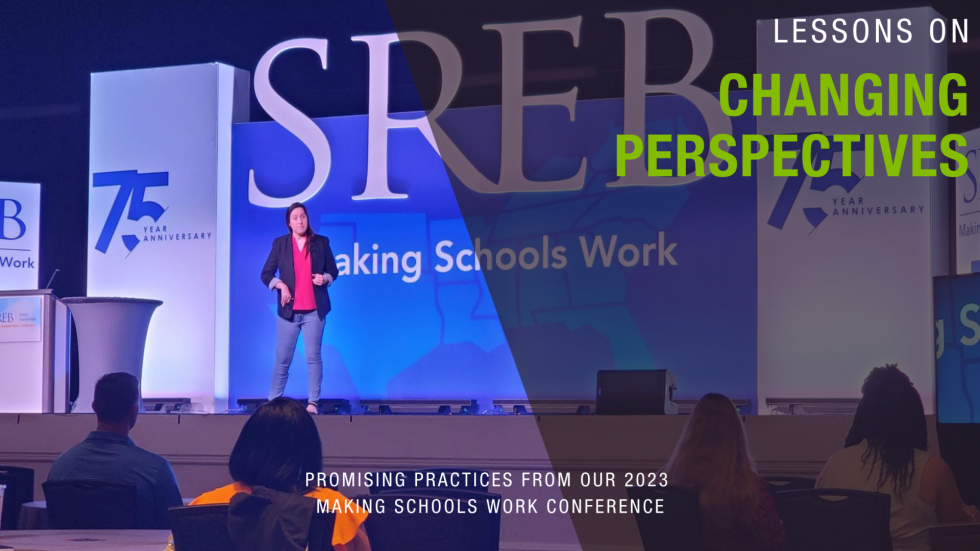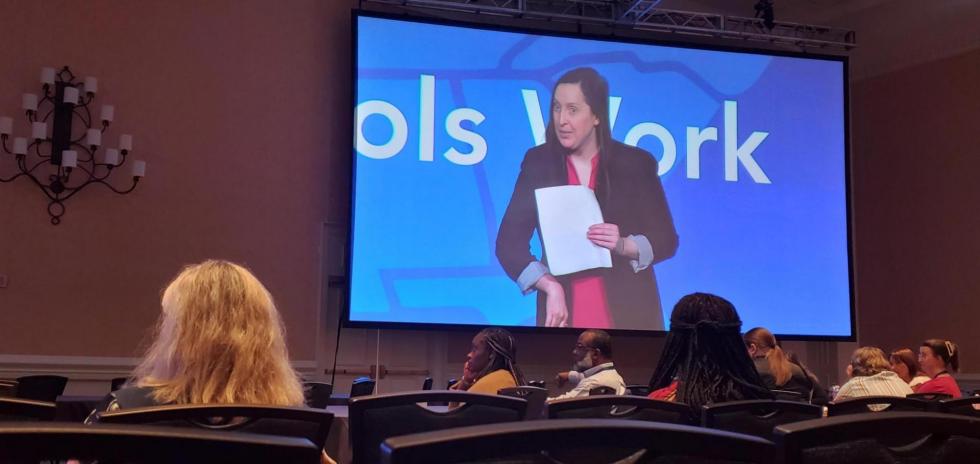Is Your Glass Half Empty or Full? Lessons From Kelsey Tainsh on Shifting Perspectives to Improve Schools
Prefer to listen? Check out the audio recording of this post instead.
Last week, I got a flat tire on my way to the grocery store. It was a Saturday, and so every shop around me was closed. I finally found a place that could help, but they were packed (because they were the only place around that was open). I had my car towed there, and then got a ride home – where I found out that my air conditioning had stopped working while I was out. It’s no fun to be without AC in Georgia in the middle of summer.
Let me just put this simply: It wasn’t my best day.
Eventually, though, my car was fixed, and my AC was back on. I picked up my groceries, and I sent out a message to a few people who knew my struggles: “I’ve got a car with four-working wheels, a house with AC, and food. Tonight is a lot better than today.”
That morning, I wouldn’t have thought about those things as reasons my night was so good. They would have just been givens. However, a few roadblocks, and my perspective was changed. Suddenly, I had to figure out new ways to overcome things that usually required no thought on my part. In doing so, I not only faced a challenge head on, but I also got a moment to realize that a bad day often isn’t as bad as it feels in the moment.
Let me stop talking about myself, though, because this post isn’t about me. It’s about someone who demonstrates this lesson in a much more impressive way than I ever have: Kelsey Tanish.
I attended her featured session at the 2023 Making Schools Work Conference, and it is what I’ll be writing about in today’s Promising Practices post.
To understand her perspective, though, you first need to know a little bit about her.
Kelsey Tainsh
Kelsey was just 5-years old when her family learned she had a brain tumor. Doctors told her there wasn’t much they could do because operating would cause a stroke. However, her parents wouldn’t take “No” as an answer and pushed until a surgery was scheduled.
And it was a success!
A now healthy little girl spent the next 10 years of her life becoming a champion wakeboarder, with that tumor just a blimp on her radar. Then, when she was 15, the seizures started.
While she first tried to hide it from her large family (she herself was a triplet, the second set of kids birthed to her parents after her older siblings, the twins), it soon became impossible to hide, and the doctor confirmed the bad news: The tumor was back.
Like last time, Kelsey chose to have surgery, but this time the results were different. During the operation, she had a stroke, and when she woke up, she learned the dominant half of her body was paralyzed.
At just 15, Kelsey had lost her ability to walk, the use of half of her body, her friends and her confidence. However, she gained a determination to not let the stroke stop her from doing the things she wanted to do.
Because of this determination, she worked hard and never took the people who told her no seriously. Today, she can walk and live on her own with no assistance. She graduated with honors from the University of Florida, where she spent most semesters getting to study abroad, and she has worked for one of the most well-known companies in the country.
On top of all these feats, she is also a motivational speaker, whose clients have included companies like Coca-Cola and Harvard Medical School, and a prolific writer, with pieces in outlets like the Orlando Sentinel and Our Town Magazine.
In other words, Kelsey is an impressive person, and having a tumor and a stroke was not going to stop her from letting the world see that.
At the Making Schools Work Conference, Kelsey titled her featured session, “I’m Not Limping. That’s Swagger! How Shifting Perspectives Can Improve School Potential.” The name alone gives you an idea of who she is and what she wanted to accomplish with her talk.
In her speech, Kelsey credited what could have been the worst thing that happened to her as being one of the best things to ever happen to her. And it’s all because she chose to change the way she looked at her situation.
2 Lessons I Learned From Kelsey Tainsh on Improving Schools Through Shifting Perspectives
In this post, I decided to focus on two important things that Kelsey said that I think can be really useful to instructors.
Lesson 1: It’s Time to Get Rid of Words Like “Impossible” or “Can’t.”
Kelsey credits much of her success to the educators and healthcare professionals who supported her and believed in her. However, a select few still had their doubts about her recovery.
After she had been in occupational therapy for a while and was able to walk again, she decided that what she really wanted to do was put her hair in a bun on her own.
That day, she told the therapist working with her what she wanted to do and was told that it would likely never be possible.
Luckily, Kelsey inherited her parents’ stubbornness in the face of negativity. Just like they wouldn’t accept that there was nothing to be done about Kelsey’s tumor, Kelsey wouldn’t accept that she had a limitation.
So, she worked on this goal anyway. It didn’t even take her long to do. The day she made it her goal, she accomplished it. Today, she can put her hair up on her own. (See the next lesson on how she did this.)
You have many Kelseys in your class, students who would take your “No” and say, “I’m doing it anyway.” However, there are just as many, if not more, who would listen to you. If you tell them that they can’t, they may believe you and never try.
Sometimes all you have to do to help a student is believe in them and get out of their way.
Lesson 2: Sometimes the Solution Requires Looking at the Problem Differently.
When Kelsey was told that she would never be able to put up her own hair, she had a decision to make: Did she just accept that, or did she figure out a solution?
As I already pointed out in the first lesson, she decided to figure out a way to make this goal happen.
However, it took her realizing that “You’ll never be able to do this,” really meant “You won’t be able to do this the way most people do it.”
If she looked at the problem differently, she realized that there were ways she could accomplish this goal that better fit her needs.
Kelsey Tainsh demonstrates how she puts her hair in a ponytail holder.
Sometimes, the best way to help a student is to let them figure out a new way to solve the problem. Maybe the way you currently teach that problem doesn’t work for their learning style. However, that doesn’t mean they can’t solve it. They just might need a new work path.
Giving students a little bit of freedom to use creative problem solving can be an important part of teaching them because not only does it teach them perspective, but it also helps them develop confidence and learn their own strengths.
The Key Takeaways
What you learn when you struggle changes who you are. I didn’t have a bad day last Saturday; I just got a chance to remember how good I have it. Similarly, to take Kelsey’s title and apply it to teaching, your students aren’t limping when they face challenges in your classroom. They’ve just got their own swagger.
Sometimes all your students need is someone to believe in them, encourage them and give them space to find their own ways to solve problems and time to understand their strengths. If you can give them that, you can change their lives.
Want more ideas on how to help your students? Just come back here each week for more tips from our conference sessions or sign up for the Promising Practices newsletter to have them all sent to your inbox monthly.
Subscribe to Promising Practices



